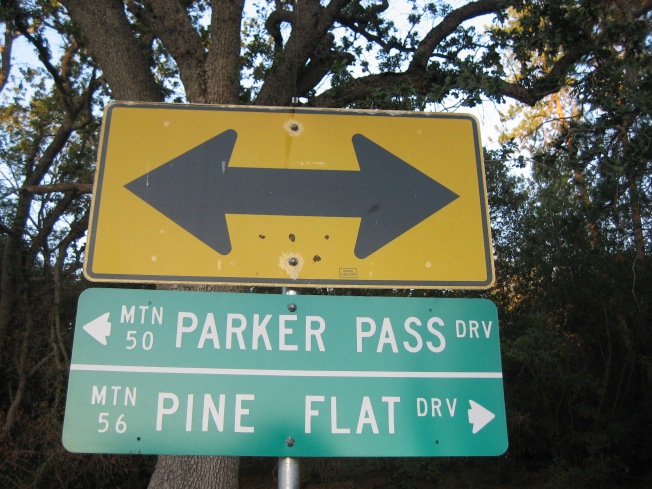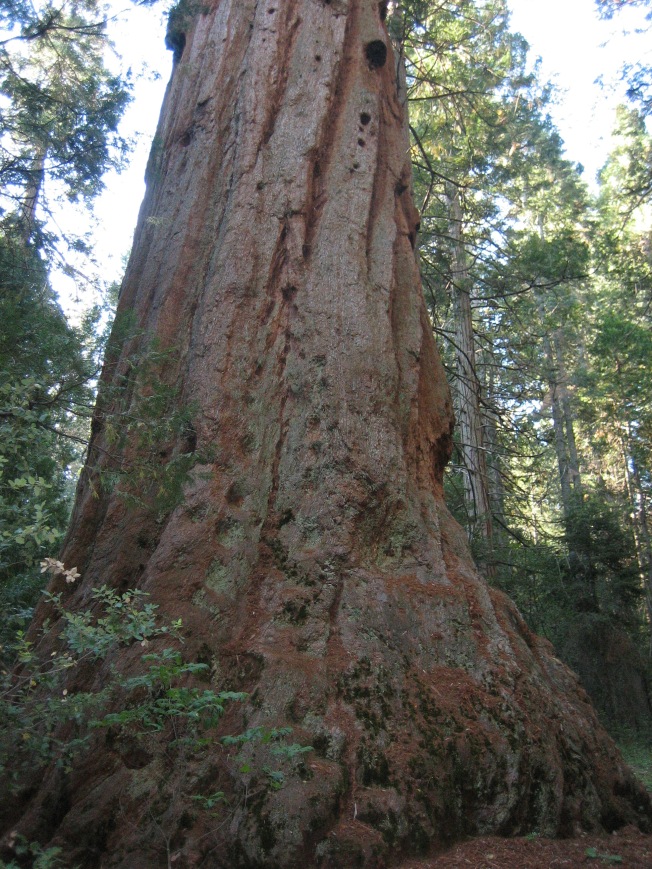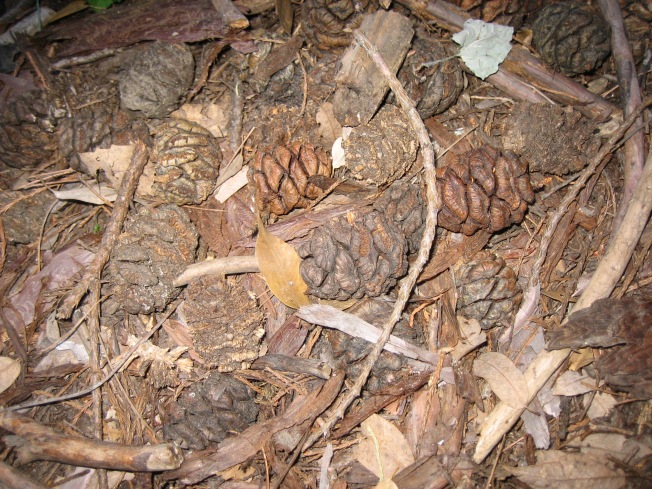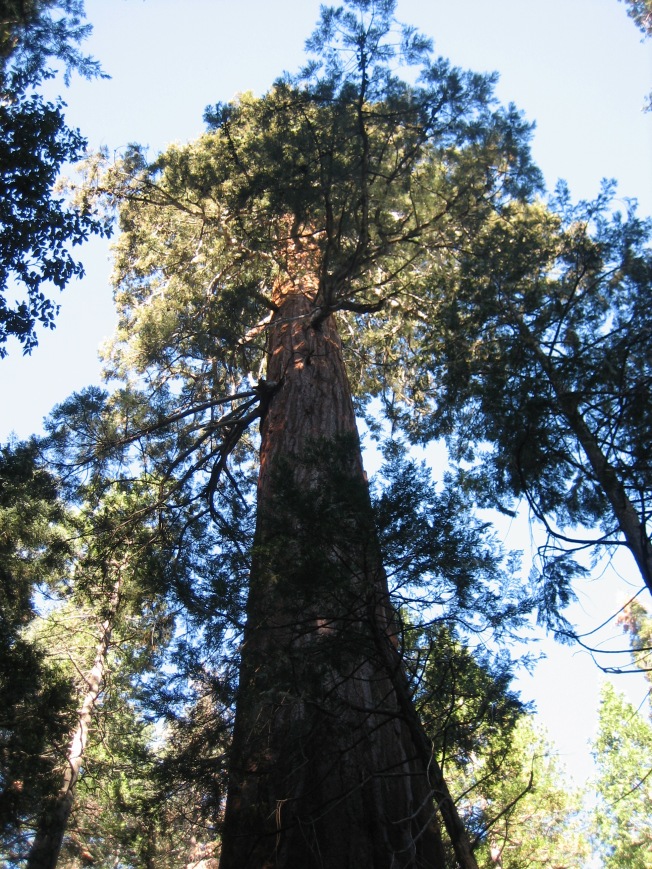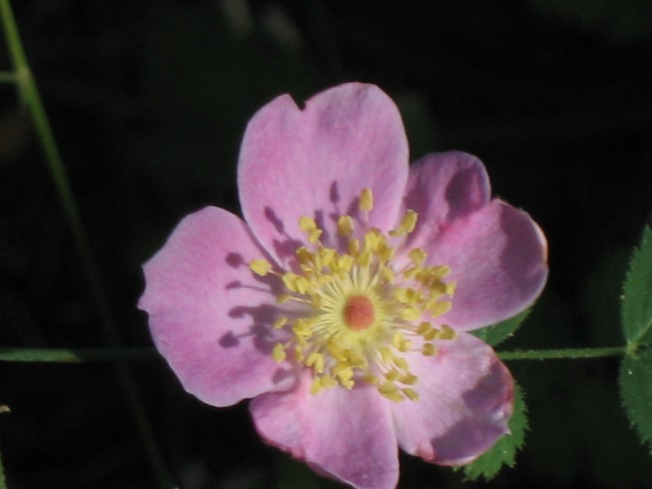
It wasn’t my finest hour.
I was lying face down in the middle of the trail, crying and whining.
I was not having fun. I did not want to go on.
The Man stood a few feet ahead of me on the trail and looked at me incredulously.
Do you want to quit? he asked, not unkindly. Do you want to go back to camp?
I know he would have accepted it if I had said yes to either or both questions.
I was miserable, but I was also determined or at least stubborn. I hauled myself to my feet and wiped the tears and snot from my face with the sleeve of my tie-dyed button-down shirt.
Let’s keep going, I said.

The whole ordeal started with a camper.
The Man was the camp host a the tiny campground where we stayed that summer. I worked down the road at the store near the trailhead of a popular trail where visitors could get up close and personal with giant sequoias.
One day The Man was talking to one of his campers. The camper told him about the great hike he’d been on. The hike wasn’t very long, only a couple of miles, and the view at the end was amazing. The camper encouraged The Man to go on the hike.
The Man told me about the conversation wit the camper. He asked if I wanted to go on the hike with him on our next day off. I said sure.

I would not call myself a hiker. I like to see natural beauty, and sometimes I have to walk around to do that. I’m not big on elevation changes; I’d rather walk along a flat path. I’m not big on long distances either. Give me a mile loop to conquer, and I’m perfectly happy. A hike consisting of a mile in and mile back is in my comfort zone.
Somehow, I didn’t give much thought to a hike of a couple of miles probably being a four mile round trip. Certainly the camper was a better hiker than I was. Probably a four mile round trip hike was easy for him. It was not easy for me.

According to the All Trails website, the Sherman Pass Trail to Sherman Peak (in the Sequoia National Forest) is
a 4.4 mile lightly trafficked out and back trail located near Kernville, California that offers the chance to see wildlife and is good for all skill levels.
One of the folks who left a review on their hike to Sherman Peak in June of 2019 recorded “an elevation gain of 994 feet.”
The SummitPost website’s page about Sherman Peak says,
Sherman Peak, elevation 9,909 feet, is on the eastern side of Sequoia National Forest on the edge of the Kern Plateau. It affords tremendous 360 degree views of the Great Western Divide, the Sierra Crest including Mt. Whitney, Langley, and Olancha, and a bird’s eye view of the Kern River Canyon and Little Kern River drainage.

I wasn’t in a good mood when we left the campground.
The Man and I were having relationship issues. I wasn’t sure if we would both be able to get our needs met. I felt like I was doing more than my share of the emotional work. I didn’t know how to solve our problems.
I wasn’t happy at work either. The yurt I worked in was always hot. One of my coworkers was difficult to get along with. The tourists seemed dumber than they had been in the past.
I would have preferred staying at our campsite and taking it easy that day. I would have enjoyed working on some blog posts, reading a book, taking a nap. However, The Man seemed to want to go on the hike, and I was pleased that he’d suggested an activity for us to do together, so I said yes.
We got a late start.
When I have an activity planned, I like to get started early. I prefer to start my summer hikes in the morning before the heat of the day sets in. I like to complete my physical activity early so I can spend the afternoon relaxing before cooking and eating dinner.
It was mid-morning before we boarded the minivan and embarked on our journey. The Man drove for a long time before we arrived. As one of the reviewers of the hike on All Trails said, this trail “is a long way from anywhere….”

The Man parked the minivan in the paved parking area at the Sherman Pass Vista. The camper had told The Man this was the best place to leave the vehicle when going on the hike. After making use of the pit toilet in the parking area, we crossed the road and found the sign marking the beginning of the trail.
The hike started our easy. The trail was relatively flat, and we were making good time without overexerting ourselves. Jerico the dog was having a great time.
We soon found that no one had been maintaining the trail. In some places we had difficulty determining where the trail actually was. There were no markers, no cairns. I was afraid we were going to wander off the path, into the forest, and to our eventual deaths. The Man continued to boldly go. I continued to follow.
The trail got worse.
In several places, trees had fallen across the path. A couple of times I had to climb over fallen trees. The Man’s long legs allowed him to step right over the downed trees, but I had to climb on top of each lot, sit in the middle, then swing one leg and then the other over.
In one spot, I had to crawl under a dead tree lying across the path. I’d never before encountered such an obstacle in my limited hiking experience.
Somehow we ended up picking our way through a patch of large rocks. The Man had lost the trail and accidentally brought us through the rocky area. The rocks were all in a jumble, so there wasn’t really space to walk between them. We basically had to walk on top of the rocks or put our feet in the crevices between them. The rocks were jagged, so walking on top of them was not an easy option. I was worried I would slip from the top of a rock and twist an ankle or bust a knee.
When we finally made it out of the rock field and found the trail again, our uphill battle became steeper. We were definitely gaining in elevation now.
It was some time after this that I lay down in the middle of the trail and felt sorry for myself.

Another problem I was having on the hike was that The Man walks a lot faster than I do. He has longer legs. He used to be a runner , so his body has muscle memory of going fast. Also, he’s impatient. He crunches his cough drops before they can dissolve in his mouth, and he surges ahead whenever we’re on a hike together.
Even though he was carrying his guitar so he could play when we reached the summit, he kept leaving me in the dust that day. Before we began the hike, I’d imagined going on an easy walk together. Instead I was looking at the back of my partner’s head in the distance.
Granted, my mood had moved from bad to foul, and I wasn’t pleasant to be around. Hell, I didn’t even want to be with me, but I was stuck. I could understand why The Man wanted to walk ahead and be alone, but feeling abandoned only made my outlook worse.

More than once The Man stopped and waited for me to catch up. Several times he asked if I wanted to turn around and go back to the minivan and head back to the campground. Each time I wanted to quit, I ultimately decided to keep going. I was fully entrenched in the sunk cost fallacy which occurs, according to Behavioral Economics website, when people
continue a behavior or endeavor as a result of previously invested resources (time, money or effort) (Arkes & Blumer, 1985).
We’ve come so far, I thought. Surely we’re not far from the top.

The trail took us higher and higher. The Man disappeared around a bend. I sat down again and cried some more.
I stood up and continued up the trail.
The camper had said the view from the peak was excellent. I hoped it would be worth all our struggles.

I came to a point where the trail forked. I could go left or right. The Man was nowhere in sight. Which way should I go?
I picked left more or less at random. I made the right decision. Next thing I knew, the trail had ended. I’d made it to the top! There was The Man and Jerico the dog.
I looked around. We were on the top of an enormous chunk of rock. There was little grass, a few evergreen trees, and some low bushes. One tree with branches low to the ground provided a bit of shade we utilized to get out of the sun.
I looked off into the distance. The view was nice…if a person had never been to Utah and seen the magnificent red rock formations.
To be fair, the view was nice in a California Sierra Nevada way. If I’d never seen that view, I might have been awestruck, but I’d seen what amounted to the same view several times in the prior three years. I’d seen basically that view from Dome Rock half a dozen times. I’d seen that view from Beetle Rock and Moro Rock in the Sequoia National Park. I couldn’t believe I’d just done a treacherous hike and the payoff was something that felt totally familiar.

I’d thrown a few granola bars in my pack before we’d left camp. The Man and I sat in the little shade provided by the evergreen tree with low branches and each scarfed down a couple of granola bars and gulped from our water bottles. The Man took out the guitar he’d carried hundreds of feet up and played a bit, but he didn’t have much energy for jamming. We were both tired, hungry, thirsty, and we still had to walk back to the minivan.

After we’d rested a bit, we looked around. There was a wooden shed up there as well as another little building and what I learned later was a radio transmitter. (I don’t know what it was transmitting or to whom.) The were a couple of large propane tanks up there too, but I don’t know if they were full or what the propane might be used for.
Once we were done poking around at the peak, we began our descent. At least our tired legs didn’t have to climb, although other little used muscles complained about going down. We managed to miss the rock patch this time. The worst was behind us.

Back on the road, we discussed going out of our way to the town with the gas station. We decided it would make more sense to go now while we were halfway there rather than having to go all the way there from our campground later in the week. We knew the fuel in the minivan wouldn’t last another week until we got our next days off and went into town.
If we go into town, I ventured, we could get a pizza.
The Man said he wouldn’t want to wait for dinner once we got back up the mountain. A pizza sounded really good, he said.
He waited in the minivan with Jerico while the air condition kept them cool. I went inside the pizza restaurant to place and pick up our order. The restaurant offered a vegetarian pizza with mushrooms and onions and green peppers and olives and broccoli. That sounded good to me.
I put ice from the soda dispenser in my water bottle and utilized the restroom (complete with a flush toilet and hot running water in the sink) while our pizza was prepared. When it was done, I triumphantly carried it out to the minivan. We devoured the whole thing while the minivan ran and pumped out cool, sweet air conditioned air. It was the best part of the day.

If I haven’t scared you off completely and you would like to hike the Sherman Pass Trail to Sherman Peak, you can find driving directions and lots of other information on the Summit Post webpage mentioned above.
What’s the worst hike you’re ever undertaken? Tell me about it in the comments section below.
The Man and I are doing fine these days, thanks for asking. In fact, we are doing better than ever.
I took the photos in this post. All were taken during the Sherman Peak hike, except for the one of the giant sequoia.































